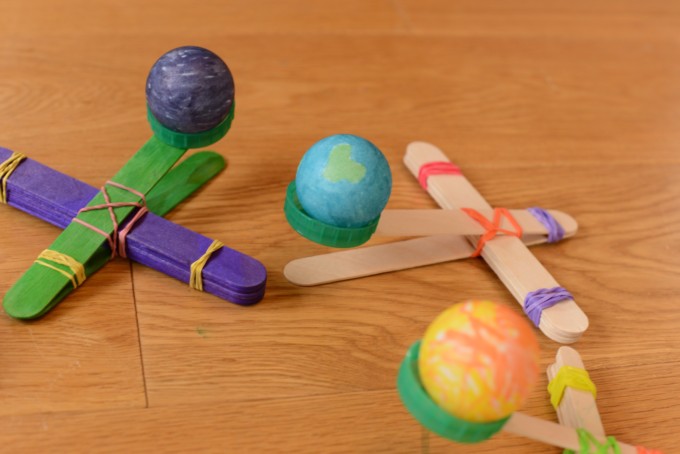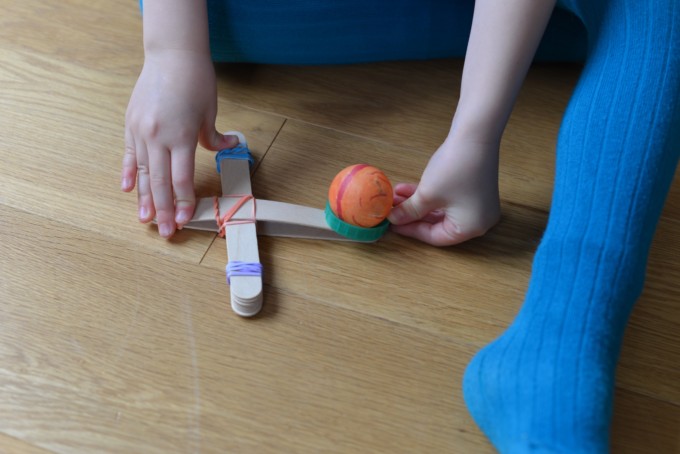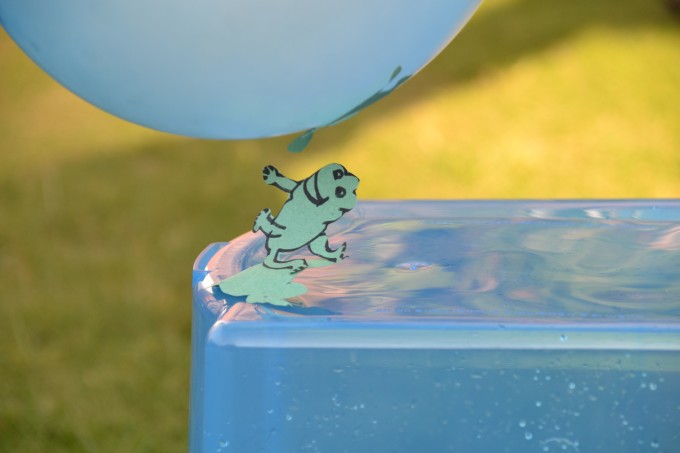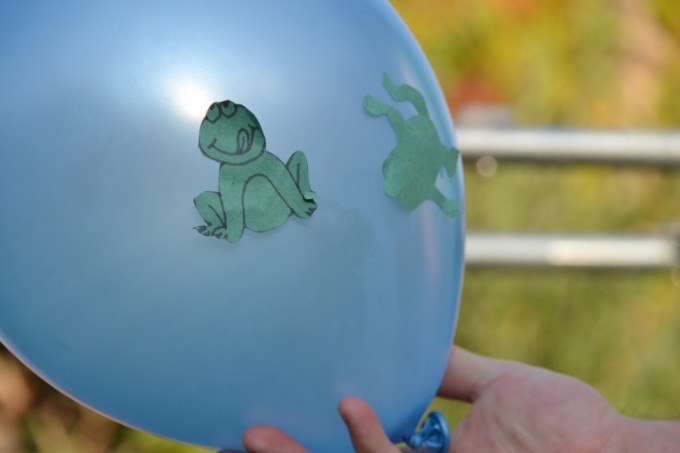This activity helped us to then classify leaves (slightly less exciting) into groups. We used all the new vocabulary that we learnt the other day to ask yes and no questions about the appearance of the leaves.
Thursday 24 October 2019
Using biscuits to classify!
In Science, Rousseau class used biscuits to practise using branching databases. We looked at whether they were sandwich biscuits, chocolate flavoured, sugary and whether they had images on top.
Wednesday 23 October 2019
Homemade Science Experiment EYFS: Jumping Frogs
JUMPING FROGS – A STATIC ELECTRICITY EXPERIMENT
Have you ever been shocked when you touch your shopping trolley or zapped when you walk on an escalator? This is caused by something called static electricity.
Static electricity takes place when energy is stolen from one object and given to another. Balloons and wholly jumpers are two examples of objects which are famous for stealing energy from other objects around them.
- Blow up a balloon (you will need this for the next experiment - so don't pop it!)
- Rub the balloon against your hair (the quicker the better)
- Look in the mirror!
This is caused by static electricity. The balloon is stealing charge from your hair causing it stand on end.
Main Experiment: Jumping Frogs
JUMPING FROGS – A STATIC ELECTRICITY EXPERIMENt
EQUIPMENT
- Balloon
- Paper, cut into shapes. We used sugar paper, but tissue paper would also work brilliantly.
- Woolly jumper or hair
METHOD
Cut up your different types of paper into frog shapes (or anything else you want to make jump)
Blow up your balloon, and rub it on your jumper or hair. Hold above the frogs, and watch them jump up.
HOW DOES THIS STATIC ELECTRICITY EXPERIMENT WORK?
Rubbing the balloon on your jumper or hair, charges it with static electricity, this attracts the frogs making them jump up to the balloon. They will stick until the charge wears off.
MORE STATIC ELECTRICITY EXPERIMENTS
Does it still work if you use normal paper and cardboard?
Can you time how long the frogs stay stuck for?
Do smaller frogs stick for longer than bigger ones?
Try other shapes and themes, like our jumping leaves for Autumn.
Science Kiddo uses static electricity to separate salt and pepper.
Inspiration Laboratories also has a very cool ghost static electricity activity.
Homemade Science Experiment KS1 KS2: Popsicle Stick Catapults
These popsicle stick catapults are very easy to make and provide hours of fun as well as being a brilliant engineering and design project. I've done them before using a space theme and turned the table tennis balls into planets or asteroids but there are so many different catapult designs and themes to choose from, so you can be as creative as you want!
This project is also great for a maths based activity if children record how far different size/weights of balls travel.Maybe they could even conduct some fair testing and discover how the shape of different objects affects how far the catapult can throw them?
Popsicle catapults are very easy to make. Each one takes only a couple of minutes to build once you get the hang of it.

WHAT YOU NEED FOR A POPSICLE STICK CATAPULT
- Wide popsicle sticks/ lolly sticks
- Elastic bands
- Table tennis balls or other items to test
- Double sided tape or hot glue
- Milk bottle top or the head of a plastic spoon
- Tape measure – optional
How to make your catapult:
- Start with about 7 popsicle sticks and place them on top of each other. Twist an elastic band around each end to hold them in place.
- Place another stick above and one below the stack of 7 so they make a cross shape. There should be more lolly stick on the end you want to use for the milk top.
- Tie an elastic band around the middle of the cross.
- Twist another elastic band around the bottom of two sticks as you can see in the photo.
- Attach a milk bottle top using double sided tape or strong glue.
- Experiment with your table tennis balls.

POPSICLE STICK CATAPULT INVESTIGATION IDEAS – REMEMBER TO ONLY CHANGE ONE VARIABLE AT A TIME
What happens if you add more or less lollypop sticks to the central core of the catapult?
What happens if your catapult end is shorter?
Does a heavier ball travel further?
How far can you get a ball to travel?
What happens if you make the ball heavier?
***Remember! Send any pictures to the school office under the heading: Re: Mr Wilson - Homemade Science Pictures (along with your child's name and class)
Have Fun!
**NEW** Homemade Science
Hello everyone,
It’s Mr Wilson and I have a new challenge for you!
Moving forward, I will be uploading a new science experiment every two weeks for you to complete at home.
All of the experiments will be completely voluntary which means you only need to complete them if you really want to.
These experiments should be completed with parent supervision just to be safe.
These experiments should be completed with parent supervision just to be safe.
If you take any pictures during your experiment, or once you’ve finished, you can email them to the school – just make sure you request the email to be sent to Mr Wilson, under the heading: Homemade Science Pictures along with your name.
I will select pictures to be included in the future blogs!
Have fun!
Yours sincerely,
David Wilson
Year 4 Teacher
Our new topic...
As we are starting our new Science topic afternoon half term, Rousseau class spent some time sketching the leaves we collected from the school field. We learnt lots of new vocabulary and used actions to help us remember the meanings. This vocabulary could help us to describe the leaf - such as lobed, toothed or wavy.
Our teacher was SO impressed by our sketching skills because we tried really hard to copy the exact shape of our leaf. Even though it was really difficult at first, we all applied a growth mindset and thought about what we should do make our sketches even better.
Our teacher was SO impressed by our sketching skills because we tried really hard to copy the exact shape of our leaf. Even though it was really difficult at first, we all applied a growth mindset and thought about what we should do make our sketches even better.
Tuesday 22 October 2019
Year 5 Magritte Science - The Gravity Well
Last week we investigated why the planets orbit the sun. Using a sheet of spandex stretched over a hoop we were able to demonstrate how gravity pulls planets towards the sun and, because of their orbital velocity, they go around the sun in a circle.
We were even able to demonstrate the creation of the solar system and explain why all the planets spin in the same direction.
Out on the playground we made our own human solar systems and explored how long it takes for different planets to move around the Sun. Do you know how long it takes for the Earth to go around the Sun? Do you know how long it takes Neptune to go around the Sun?
Year 5 Magritte Science - The Phases of the Moon
In science today we used a light source and hockey balls to explore the phases of the moon. We were able to demonstrate full moons, half moons, new moons, crescent moons, gibbous moons, waxing moons and waning moons. We even showed lunar and solar eclipses! Next time you look at the moon, can you describe exactly what you are seeing?
Reception: Diwali
In Reception, we have been learning about a very special Hindu festival called Diwali, which is celebrated by many people all over the world. It is a festival to mark new beginnings and the triumph of light over darkness. Although many of us don't celebrate Diwali, we found some similarities in the way in which we celebrate special occasions, such as watching fireworks, dressing up, eating yummy food and decorating houses!
The children loved hearing about Rama and how he saved his wife Sita from the wicked King Ravana. It got children thinking about different characters in stories, and how there are often 'good' characters and 'bad' characters. This inspired a great deal of storytelling! The children took it in turns to tell their own stories during their choosing time...
Pinky the Triceratops
by Milla
Pinky the triceratops is trying to save itself from the
T-Rex. The T-Rex is trying to eat the
triceratops. The bad T-Rex is called Mr
McIntosh!
Red Riding Hood
by Darcie
Miss Riding Hood is sitting down on the sofa watching
T.V. The wolf is coming to eat her.
Red Riding Hood
by Charlie
The Big Bad Wolf is sitting doing nothing. Red Riding Hood is taking brussels sprout
soup to grandma. The wolf wants to eat
Red Riding Hood and Grandma but not the brussels sprout soup!
The Power Ranger
by Rylee
The Power Ranger is fighting Ravanna the ten headed King because he is naughty.
Red Riding Hood and the Big Plum
by Eva
The big giant plum came alive and tried to eat little Red
Riding Hood and the big bad wolf saved her.
He is a Big Good Wolf and he ate the plum!
The children also enjoyed making their own little Diyas, small candle holders to celebrate the festivals of light!
"Even though I don't celebrate Diwali, it's okay to believe different things!"
- Ariana
Year 1’s RE and investigation work
The children have been learning about Sukkot in RE - a Jewish festival, held in the Autumn. After hearing about how people celebrate within a special ‘sukkah’, the children helped to design their own sukkah shelter.
The children have also been investigating how to get leaves out of frozen blocks of ice. During the children’s child initiated time this week, some children have been attempting to release the leaves and discussing how best to get them out! They tried warming up the blocks with their hands, pouring water over them and even just chipping away at them with cutlery!
Learning to Sew
Kusama class have loved learning how to sew! We are designing and making flames to link with our Great Fire of London topic. Lots of us have talked about how sewing makes us feel calm and relaxed. We have all needed to be 'Agent Perseverance' at times, especially when trying to thread a needle!
Who was to blame for the Great Fire of London?
In Year 2 we have been learning all about the Great Fire of London. We were asked 'Was Thomas Farriner to blame for the Great Fire of London?' and voted with our feet.
We then spoke in our trios about whether it was all the baker's fault or if there are other reasons for why the fire was so devastating.
Finally we had a 'talk battle' to argue our opinion, using our voices and body language to be persuasive!
We then spoke in our trios about whether it was all the baker's fault or if there are other reasons for why the fire was so devastating.
Finally we had a 'talk battle' to argue our opinion, using our voices and body language to be persuasive!
Monday 21 October 2019
Nursery catches the 'Gingerbread Man.'
We have been very busy in nursery this week having lots of fun cooking. We first read the story ‘The Gingerbread Man’ and then made vegan biscuits in the shape of a gingerbread man. The children all had a turn rolling out the dough and then using the cutter to make the gingerbread man shape. I cooked the biscuits and the next day the children were so excited as they all got to decorate them with icing. We counted how many eyes and buttons the gingerbread man needed and then put the correct amount raisins on and added a colourful smile. When it was home time everyone had a lovely treat to eat and were very proud to show their grown up what they had made.


Sunday 20 October 2019
Year 5 Newsletter
What another action-packed fortnight we have had in year 5. Having learnt about the solar system and the relative distances between planets, we were enthralled by the globes of the planets in our solar system during our visit to the Whipple Museum in Cambridge. We also showed off our knowledge of the Mayans in the Museum of Archaeology and Anthropology as we examined real Mayan artefacts and learnt about the work of Alfred Maudsley (the father of Maya archaeology) through his plaster casts. And who could have guessed that the Ancient Maya invented whisks in order to have frothy hot chocolate?
Despite enjoying our trip to Cambridge, the highlight of the past fortnight has been our writing. Creating empathy and atmosphere, we have all been inspired to write first person anrratives as children trying to escape to America by travelling across Mexico from modern day Guetemala. We are rightly proud of our achievements.
Despite enjoying our trip to Cambridge, the highlight of the past fortnight has been our writing. Creating empathy and atmosphere, we have all been inspired to write first person anrratives as children trying to escape to America by travelling across Mexico from modern day Guetemala. We are rightly proud of our achievements.
Year 3 Newsletter
The human skeleton, muscles and joints have been the focus for our science lessons recently and we've loved learning some fun facts about our bodies! In order to label the bones on a human skeleton, the children had to first find the correct information from the posters around the classroom. They completed a range of exercises to find out which muscles they used, found out about different types of joints and made a hinge joint to show how a muscle works by contracting and relaxing.




In PSHE, we have been learning some facts about cigarettes and alcohol which led us to sorting things that can help or harm us such as medicine, food, exercise, cigarettes, alcohol and sleep. We decided that both food and medicine can help us but can also harm us if not taken properly so we made posters to explain this.
In English, we've been planning our own fables and will be writing these this week. We can't wait to read them! In our topic lesson, we've learned how pyramids were built and will be re-enacting this over the next few days!




In PSHE, we have been learning some facts about cigarettes and alcohol which led us to sorting things that can help or harm us such as medicine, food, exercise, cigarettes, alcohol and sleep. We decided that both food and medicine can help us but can also harm us if not taken properly so we made posters to explain this.
In English, we've been planning our own fables and will be writing these this week. We can't wait to read them! In our topic lesson, we've learned how pyramids were built and will be re-enacting this over the next few days!
Friday 18 October 2019
How clean are your hands?
As part of Year 2's Science topic, we have been learning about personal hygiene. We’ve discussed all the ways we can stay clean and healthy, such as brushing our teeth, showering and washing our hands.
But, we wanted to find out how important it actually was to wash your hands.
Does washing your hands really reduce the amount of bacteria on them?
Warhol and Kusama Class decided to investigate….
We started with three slices of bread.
The first slice of bread was our control slice. We placed the bread inside a ziplock bag. We did not touch the bread with our hands.
We passed around a second piece of bread with our dirty hands and put it into a ziplock bag.
We washed our hands with soap and warm water to get rid of the bacteria and germs. (We remembered to sing Happy Birthday twice to check we had washed them for long enough). We then passed around a piece of bread with our clean hands and put it into our ziplock bag.
We put a damp paper towel into each ziplock bag because we know that bacteria grows in warm, damp conditions.
The first slice of bread was our control slice. We placed the bread inside a ziplock bag. We did not touch the bread with our hands.
We passed around a second piece of bread with our dirty hands and put it into a ziplock bag.
We washed our hands with soap and warm water to get rid of the bacteria and germs. (We remembered to sing Happy Birthday twice to check we had washed them for long enough). We then passed around a piece of bread with our clean hands and put it into our ziplock bag.
We put a damp paper towel into each ziplock bag because we know that bacteria grows in warm, damp conditions.
“I predict that the dirty hands one will go the mouldiest because
the whole class touched the bread with dirty hands.”
“I predict that the dirty hands bread will go mouldy in one
day. The clean hands bread will go mouldy in 3 days and the control bread will
go mouldy in a month because it has no bacteria on.”
A week later, we looked closely at the bread and gathered
our results. We couldn’t believe how much mould had grown on the ‘dirty hands’ slice in
a week! Yuck!


Year 1 Newsletter
Year 1 have been busy outside in our outside area this week! We have been planting seeds, investigating tree trunks, making our own homes for Spiky and drawing woodland animals. In our forest session, we received an email from Mrs Moore telling us that the forest might be cut down to make a bigger playground. We came up with lots of reasons as to why this wasn't a good idea and have been writing letters to Mrs Moore with our reasons. In maths, we have been using the cherry model and ten frames to represent our whole number and its parts, using the manipulatives to help us. In science, we have been investigating the trees in our school playground. Our big question was 'Do shorter trees have bigger trunks?'
Year 4 newsletter
Rousseau and Picasso class have had another just week finishing their hot tasks, making switches in Science and absolutely smashing column addition in maths! In ICT we used branching databases to ask Andy answer questions about people in our class!
The children have enjoyed practising the times table check online at: maths frame multiplication check. Feel free to practise at home!
We even found time to visit the Year 1 and 2 classes to read their favourite books with them!
The children have enjoyed practising the times table check online at: maths frame multiplication check. Feel free to practise at home!
We even found time to visit the Year 1 and 2 classes to read their favourite books with them!
Subscribe to:
Posts (Atom)












































